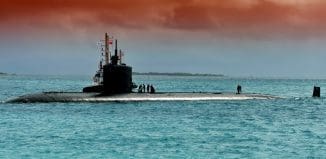“Almost jet” Submarine – i-HLS Special
This post is also available in:  עברית (Hebrew)
עברית (Hebrew)

To read this article in Hebrew
.
.
 Will Russian technology that is leaking to Iran allow Tehran to develop very fast submarines that can also endanger Israel? Is this revolutionary technology “ripe” and mature at all? These questions currently employ western experts.
Will Russian technology that is leaking to Iran allow Tehran to develop very fast submarines that can also endanger Israel? Is this revolutionary technology “ripe” and mature at all? These questions currently employ western experts.
The Exposure of Worrisome Technology
By Ami Dor-on
One of the innermost technological advancements in the field of “underwater propulsion – Marine speed”, which would cause a real revolution in strategic worldview submarine operations was invented in the Soviet Union. This new technology includes significant improvement in the means of shooting underwater “Torpedoes.” The Russians are ahead of its all the super-powers and has therefore become a magnet for espionage activities of most western intelligence agencies.
The existence of this revolutionary technology was exposed to the attention of the world, when a retired American intelligence officer named Edmond Pope was arrested in Moscow by the Russian Intelligence Service agents in April 2000. Pope contacted an expert on Russian torpedo seeking to obtain information about the latest torpedo speed-cruise VA-111 model. Pope was accused of spying and was the second American to be put on trial in the Soviet Union for such serious espionage charges since Francis Powers, the American U-2 spy-plane pilot. Pope was sentenced to 20 years in prison. In the end he didn’t spend the time in prison on the orders of Vladimir Putin and was released and returned to the United States.
The code name of the secret Soviet project was “Strong Storm” and the primary objective of the Soviet program was to develop a torpedo that can reach underwater cruising speed exceeding 4-5 times that of normal torpedo while under significant and increased operational efficiency. After years of research and hundreds of experiments this modern torpedo was introduced into the Soviet Navy for operational use in November 1972. Five years later, the system entered its final stage and went into “industrial” production.
In those days there were experts who compared the new technological revolution to the one that had occurred in the airline industry when manufacturers moved to propeller operated jet engines. These experts believed that from that time on it would be possible to rename any underwater vessel activated by the new method, with the title of “Almost a jet-powered submarine.”
At this stage of the new system the operating principle of this important technological secret was leaked to the Western world. The inevitable result: In 1994, U.S. Navy scientists began to develop their own torpedo, intended initially to engage in a controlled explosion of mines. Code-name for the project was a “torpedo”. The RAMICS (Rapid Airborne Mine Clearance System) development, which excited the minds of scientists around the world, delivered results. In 2004, a German industrial company announced they had failed to produce a torpedo, carrying the name of the fish-eating “Barracuda”. The German manufacturer’s statement published in the media stated that “Barakuda” could reach cruising speed sub-water of 400 kilometers per hour. In those days such a great speed was completely imaginary if not unacceptable.
Before long it was realized that scientists should coordinate their efforts in order to produce underwater propulsion systems of the sort that the modern technology would not only work on torpedoes but would also propel submarines. In 2005 an American company announced that it was actively promoting a project called “Underwater Express” with the “aim to develop an underwater vessel capable of leading underwater combat forces and combat equipment at up to 160 km per hour.
A contract to produce this vessel was awarded in 2006 to two U.S. companies: Northrop Grumman and General Dynamics Electric Boat. The real surprise came three years after the start of work when Electric Boat Company managed to build a unique model of a submarine operated with the new method. This dramatic announcement was the first practical step towards the biggest revolution in submarines. It was dramatic for the simple reason: anyone who engaged in moving submersible submarines well knew that “normal” meant cruising speed underwater was 25-30 nautical miles (46-54 mph) maximum. However submarines of these newest models were able to move at underwater speeds reaching a 100 nautical miles (185 mph).
To clarify the enormous importance of the new method, some technical explanation is required. Conventional propeller wings of marine vessels were built with 3-4 blades much like fan blades used at home. Blades of this type were employed on torpedoes and used operationally at sea for decades. There were two fundamental shortcomings involved in that technology. One was due to the screw “chewing” the water and forming cavitating (bubbles) that indicated the exact cruising speed and direction. The second shortcoming involved “cutting” the water which created a sort of vacuum behind the propeller and severely limited the options for increasing the cruising speed beyond a certain threshold. As the rotational speed of the propeller wings full width, even when parts of the propeller blades left the water, the drag force increased creating a curbing and negative acceleration forward.
Operating marine craft with the new method enables a significant increase in cruise speed under water while significantly reducing cavitating noises that occur when you start the propellers in the existing system. There are at least two very significant operational results. First, due to the high speed, the vessel can reach larger activity ranges without increasing fuel consumption. In other words, it enabled travelling further distances on the same amount of fuel. The second result was a reduction in the noise gurgling of the submarine making it harder for hostile vessels operating their sonar systems to detect and harm their target before it had completed its operational mission.




























